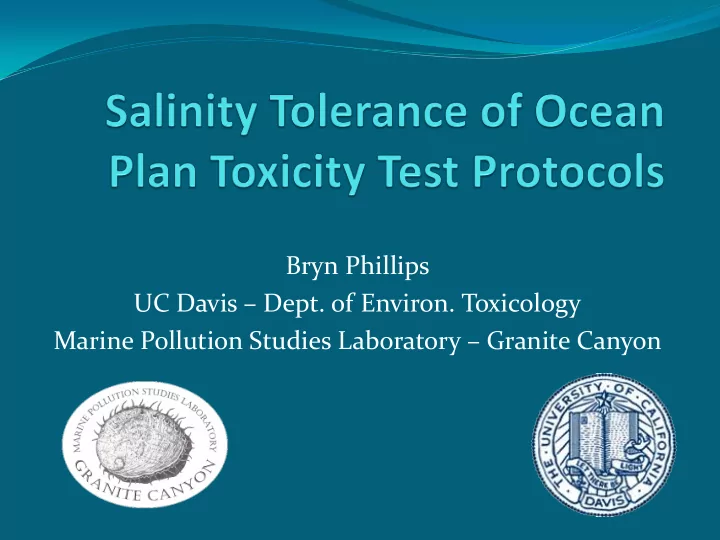

Bryn Phillips UC Davis – Dept. of Environ. Toxicology Marine Pollution Studies Laboratory – Granite Canyon
Toxicity Test Protocols U.S. EPA 1995 (EPA/600/R-95/136) 1. Red Abalone ( Haliotis rufescens ) 48h embryo development 2-3. Purple Urchin ( Strongylocentrotus purpuratus ) 72 h embryo development and 20 min fertilization 4-5. Sand Dollar ( Dendraster excentricus ) 72 h embryo development and 20 min fertilization 6. Mussel ( Mytilus galloprovincialis ) 48h embryo development
Toxicity Test Protocols U.S. EPA 1995 (EPA/600/R-95/136) 7. Giant Kelp ( Macrocystis pyrifera ) 48h germination and growth 8. Mysid ( Americamysis bahia ) 7 d survival, growth, and fecundity (U.S. EPA 2002 (EPA/821/R-02-14) 9. Topsmelt ( Atherinops affinis ) 7 d survival and growth
Experimental Question What is the upper salinity tolerance of each protocol? Experimental Approach Conduct one range-finder test and two definitive tests using brine prepared from frozen seawater (US EPA 1995 EPA/600/R- 95/136). Each test included a minimum of five salinity concentrations and a control. Data analysis was conducted to determine NOEC, LOEC and EC50 or EC25.
Additional Testing Seawater reverse osmosis desalination discharge effluent from the Monterey Bay Aquarium was tested with mussels, giant kelp and topsmelt protocols. Effluent concentrations ranged from 0 to 100% (34 to 55‰). Also tested brine prepared from Tropic Marin™ artificial sea salt. Duplicated the concentrations tested in the first definitive test for purple urchin development and fertilization protocols, and the mussel development protocol.
Results – Salinity Tolerance Abalone Topsmelt 100 100 90 90 80 80 Percent Survival Percent Normal 70 70 60 60 50 50 40 40 30 30 20 20 10 10 0 0 34 35 36 37 38 39 40 41 42 43 30 35 40 45 50 55 60 65 70 75 Salinity (PPT) Salinity (PPT)
Results – Salinity Tolerance Protocol NOEC LOEC EC50/25 Mean EC Red Abalone Development 34.9 35.6 36.4 36.8 35.9 35.6 37.1 Purple Urchin Development 35.5 36.8 37.9 38.1 37.4 38.6 38.4 Sand Dollar Development 37.7 38.6 39.5 39.6 38.1 38.7 39.7 Sand Dollar Fertilization 37.6 39.5 41.2 40.3 37.6 39.5 39.5 Mussel Development <40.2 40.2 42.2 43.3 42.2 43.9 44.3 Purple Urchin Fertilization 41.1 43.0 44.4 44.2 41.6 41.9 44.0
Results – Salinity Tolerance Protocol NOEC LOEC EC50/25 Mean EC Mysid Survival 44.9 50.2 48.0 45.8 49.2 47.7 47.8 Mysid Growth 50.2 >50.2 >50.2 49.2 >49.2 >49.2 >49.7 Giant Kelp Germination 49 54 55.8 44 49 55.2 55.5 Giant Kelp Growth <45 45 48.3 <44 44 46.3 47.3 Topsmelt Survival 55 60 60.4 60 65 63.4 61.9 Topsmelt Biomass 55 60 57.3 60 65 61.2 59.3
Results – Salinity Tolerance Protocol NOEC LOEC EC50 LCL UCL Purple Urchin Development Frozen 35.5 36.8 37.9 37.8 37.9 Brine Tropic 35.6 36.5 37.0 37.0 37.1 Marin Frozen Mussel Development <40.2 40.2 42.2 42.1 42.3 Brine Tropic 40.1 41.2 42.3 42.2 42.4 Marin Frozen Purple Urchin Fertilization 41.1 43.0 44.4 44.3 44.5 Brine Tropic 39.1 40.6 41.9 41.8 42.0 Marin
Results – Brine Effluent Toxicity Frozen Seawater Brine Effluent Brine Protocol NOEC LOEC EC50/25 Mean EC Mussel Development 38.8 42.7 43.3 43.3 Giant Kelp Germination 53 >53 >53 55.5 Giant Kelp Growth 53 >53 51.8 47.3 Topsmelt Survival 50.8 >50.8 >50.8 61.9 Topsmelt Biomass 50.8 >50.8 >50.8 59.3
Additional Research Testing should be conducted with various brine effluent mixtures. Longer-term chronic toxicity studies should be conducted to confirm the WET protocols are adequately protective of ocean receiving systems impacted by hypersalinity (abalone, kelp, or topsmelt). Assess brine discharges in estuarine receiving systems.
Recommend
More recommend